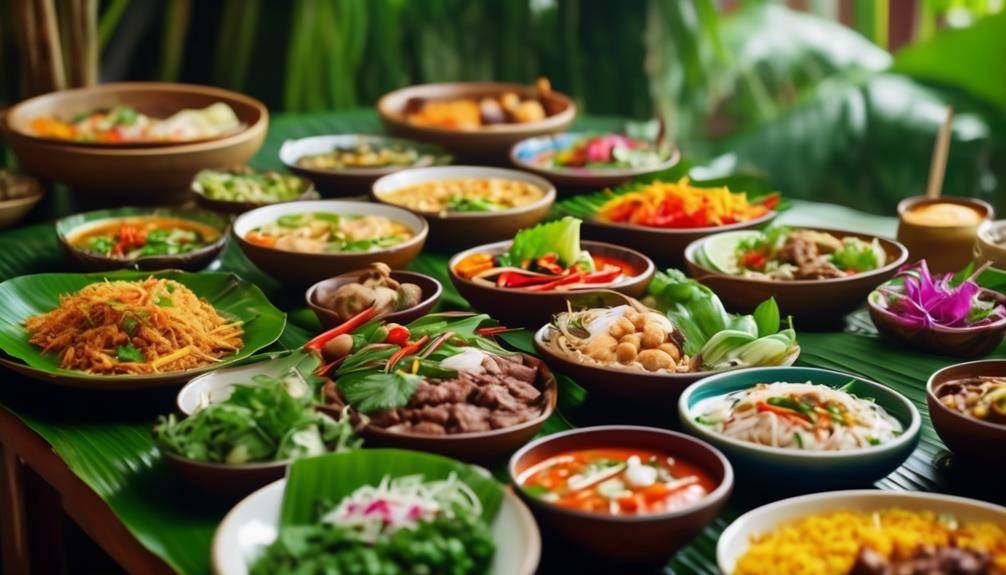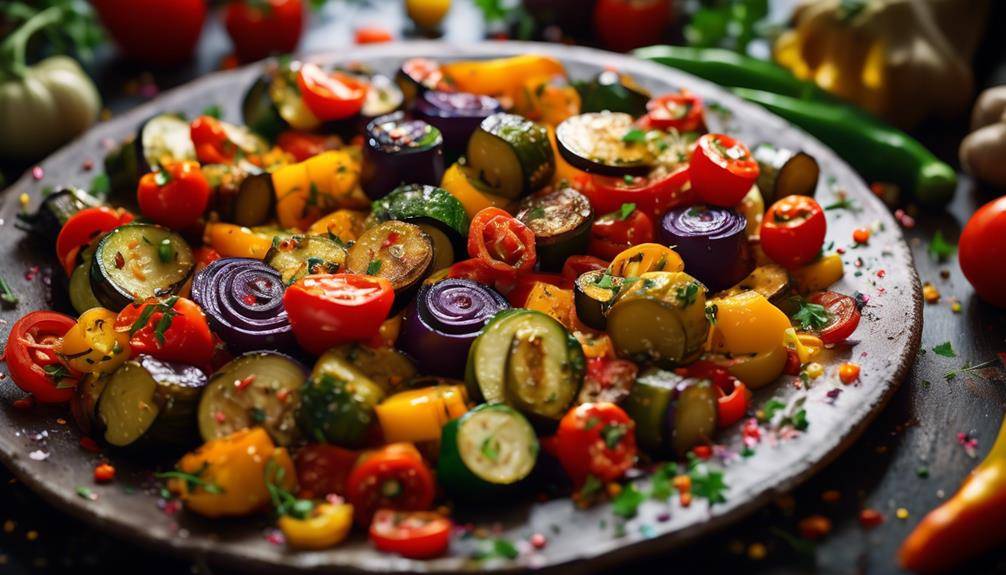The Best Healthy Thai Food Options

The Best Healthy Thai Food Options; Looking to embark on a culinary journey that celebrates both health and flavor? Thai cuisine offers a plethora of delectable options that cater to your wellness goals without compromising taste. From vibrant salads to hearty soups, from nourishing stir-fries to satisfying curries, Thai cuisine has it all. But that’s just the beginning. There are plenty of other mouthwatering dishes that await your exploration. So, why not join us as we uncover the secrets of healthy Thai food options that will leave you craving for more?
Fresh and Flavorful Thai Salads
If you’re looking for a light and refreshing option that bursts with vibrant flavors, Thai salads are the perfect choice. Thai cuisine is renowned for its fresh vegetable salads, which are not only delicious but also packed with nutrients. One popular Thai salad is the spicy papaya salad, also known as “Som Tam.” This salad is made with shredded green papaya, tomatoes, green beans, and peanuts, all tossed together in a tangy dressing. The combination of spicy, sour, and sweet flavors creates a delightful explosion in your mouth.
Fresh vegetable salads are a staple in Thai cuisine because they showcase the abundance of fresh produce available in the region. Thai salads often feature a variety of colorful vegetables such as cucumber, carrots, bell peppers, and herbs like mint and cilantro. These salads are not only visually appealing but also provide a wide range of vitamins, minerals, and dietary fiber.
The spicy papaya salad, in particular, is a standout dish. The green papaya provides a crunchy texture, while the tomatoes add a juicy element. The green beans add a touch of earthiness, and the peanuts give a delightful nuttiness. The dressing typically includes lime juice, fish sauce, palm sugar, and chili, which gives the salad its signature spicy kick. This combination of flavors makes the spicy papaya salad a refreshing and satisfying choice.
Nutrient-Rich Thai Soups
Looking to add more nutrients to your diet? Thai soups are a great option. Packed with a variety of ingredients such as vegetables, herbs, and proteins, these soups offer a range of health benefits. From boosting your immune system with ingredients like lemongrass and ginger to providing a flavorful and satisfying meal, Thai soups are a delicious way to nourish your body.
Ingredients for Thai Soups
To create nutrient-rich Thai soups, incorporate a variety of fresh vegetables, aromatic herbs, and flavorful spices. Traditional Thai soup recipes often include ingredients like lemongrass, galangal, kaffir lime leaves, and Thai basil for their distinct flavors and health benefits. These herbs are known for their antioxidant and anti-inflammatory properties, which can support overall health and wellbeing. Along with herbs, Thai soups are packed with an assortment of vegetables such as mushrooms, carrots, bell peppers, and bok choy.
These vegetables add texture, color, and a range of essential vitamins and minerals. To enhance the flavors, spices like chili, garlic, and ginger are commonly used. These ingredients not only add a kick to the soup but also offer potential health benefits, including improved digestion and a strengthened immune system. By combining these nutrient-rich ingredients, you can enjoy a delicious and nourishing bowl of Thai soup.
Health Benefits of Thai Soups
To fully appreciate the health benefits of nutrient-rich Thai soups, it is important to understand how the combination of fresh vegetables, aromatic herbs, flavorful spices, and traditional ingredients can contribute to your overall well-being. Thai soups are packed with vitamins, minerals, and antioxidants, making them a nutritious choice for your diet. The use of fresh vegetables like lemongrass, galangal, and lime leaves provides essential nutrients and adds a burst of flavor to the soups.
The aromatic herbs and spices, such as coriander, basil, and chili, not only enhance the taste but also offer numerous health benefits. These ingredients have antimicrobial, anti-inflammatory, and antioxidant properties. The traditional flavors of Thai soups not only satisfy your taste buds but also support your immune system, digestion, and heart health. Incorporating these nutrient-rich soups into your diet can be a delicious way to boost your overall well-being.
Flavor Profiles in Thai Soups
The flavor profiles of nutrient-rich Thai soups are a harmonious blend of fresh vegetables, aromatic herbs, and flavorful spices that tantalize your taste buds while providing a wealth of health benefits. Thai soups are known for their balanced and complex flavors, achieved through unique flavor combinations and cooking techniques. The use of ingredients like lemongrass, kaffir lime leaves, and galangal adds a refreshing and citrusy note to the soups.
These ingredients, along with Thai chilies, provide a subtle heat and depth of flavor. Thai soups often incorporate a variety of vegetables, such as mushrooms, bamboo shoots, and bok choy, which not only enhance the taste but also contribute to the nutritional value. The cooking techniques, such as simmering and stir-frying, help to infuse the soup with the flavors of the ingredients, resulting in a rich and satisfying broth.
Wholesome Thai Stir-Fries
When it comes to wholesome Thai stir-fries, you have a plethora of options that are both delicious and nutritious. Nutrient-packed vegetable stir-fries are a great way to incorporate a variety of colorful vegetables into your diet, providing you with essential vitamins and minerals. If you’re looking for a protein boost, lean protein stir-fries with chicken, tofu, or shrimp can be a satisfying and healthy choice. Plus, these flavorful stir-fries can be prepared with low-calorie sauces and seasonings, making them a guilt-free option for those watching their calorie intake.
Nutrient-Packed Vegetable Stir-Fries
For a nutrient-packed meal that will satisfy your taste buds and nourish your body, try indulging in wholesome Thai stir-fries loaded with vibrant vegetables. These nutrient-packed vegetable stir-fries not only provide a burst of flavors but also offer a plethora of health benefits. Packed with vitamins, minerals, and fiber, the colorful array of vegetables in these stir-fries promote good digestion, support a healthy immune system, and provide essential nutrients for overall well-being.
By incorporating nutrient-dense vegetables like broccoli, bell peppers, carrots, and mushrooms, you can create a delicious and healthy dish that is low in calories and high in nutritional value. Additionally, these stir-fries can be paired with healthy Thai noodle dishes like pad Thai or drunken noodles for a satisfying and complete meal. So, go ahead and enjoy a plateful of these nutrient-packed vegetable stir-fries to fuel your body with goodness.
Lean Protein Stir-Fries
Indulge in a flavorful and nutritious meal by trying out lean protein stir-fries as part of your wholesome Thai cuisine. These balanced stir-fry recipes are packed with healthy protein and offer a variety of delicious options. Here are four healthy protein stir-fry variations to consider:
- Chicken and Vegetable Stir-Fry: Lean chicken breast cooked with an assortment of colorful vegetables like bell peppers, broccoli, and snow peas. Add a light soy sauce or ginger-garlic sauce for extra flavor.
- Shrimp and Asparagus Stir-Fry: Succulent shrimp paired with fresh asparagus spears, mushrooms, and onions. Season with a tangy lime and cilantro sauce for a burst of taste.
- Tofu and Bok Choy Stir-Fry: Firm tofu combined with tender bok choy, carrots, and bean sprouts. Drizzle with a sesame sauce for a nutty and savory twist.
- Beef and Green Bean Stir-Fry: Thinly sliced beef stir-fried with crisp green beans, onions, and garlic. Enhance the taste with a spicy chili and soy glaze.
These lean protein stir-fries offer a satisfying and wholesome option for a nutritious Thai meal. Enjoy the flavors while nourishing your body with these delicious dishes.
Flavorful and Low-Calorie Options
Experience the delightful combination of flavor and nutrition with these wholesome Thai stir-fries that offer a low-calorie option for a satisfying meal. Thai cuisine is known for its bold flavors, and you can enjoy them while maintaining a healthy diet. To add flavor to your stir-fries, opt for healthy Thai condiments like fish sauce, lime juice, and chili peppers. These ingredients not only enhance the taste but also provide essential nutrients.
Additionally, when choosing beverages to accompany your meal, consider low-calorie Thai options such as herbal teas or fresh coconut water. These beverages are refreshing and hydrating, without adding unnecessary calories. By incorporating flavorful and healthy Thai condiments and opting for low-calorie Thai beverages, you can enjoy the deliciousness of Thai cuisine while keeping your calorie intake in check.
Lean and Protein-Packed Thai Curries
If you’re looking for a flavorful and nutritious meal, Thai curries are an excellent choice. Not only are they packed with bold and aromatic flavors, but they also offer several health benefits. Here are four reasons why lean and protein-packed Thai curries should be on your menu:
- Variations: Thai curries come in various types, such as red, green, yellow, and massaman. Each variation offers a unique blend of spices and ingredients, ensuring a diverse range of flavors to suit your taste preferences.
- Protein Powerhouse: Thai curries are typically made with a protein source like chicken, beef, or tofu. These proteins provide essential amino acids, which are the building blocks of our body. They help repair tissues, support muscle growth, and contribute to overall health and wellbeing.
- Nutrient-Rich Vegetables: Thai curries also include a generous amount of vegetables like bell peppers, broccoli, carrots, and spinach. These colorful veggies are rich in vitamins, minerals, and dietary fiber, which promote good digestion, strengthen the immune system, and contribute to a balanced diet.
- Coconut Milk Goodness: Coconut milk is a key ingredient in Thai curries. While it adds creaminess and richness to the dish, it also offers health benefits. Coconut milk contains healthy fats that can help improve cholesterol levels and provide sustained energy.
Healthy Thai Noodle Dishes
Looking for nutritious noodle options to enjoy your favorite Thai dishes without the guilt? You’re in luck! Thai cuisine offers a variety of low-calorie noodle choices that won’t compromise on flavor. Additionally, if you have dietary restrictions, there are gluten-free noodle alternatives available that can cater to your needs.
Nutritious Noodle Options
For a satisfying and nutritious meal, indulge in the wide variety of healthy Thai noodle dishes available. Thai cuisine offers a range of nutrient-packed pasta alternatives and healthy noodle substitutions that can be enjoyed guilt-free. Here are four options to consider:
- Pad Thai with Rice Noodles: This classic Thai dish is made with rice noodles, which are gluten-free and lower in calories compared to traditional wheat noodles. It is typically stir-fried with vegetables, protein, and a tangy sauce.
- Tom Yum Noodle Soup: This spicy and sour soup features rice noodles, fresh herbs, and a flavorful broth made with lemongrass, lime juice, and chili. It is often served with shrimp or chicken for added protein.
- Glass Noodle Salad: Made from mung bean starch, glass noodles are a light and refreshing option. Tossed with crisp vegetables, herbs, and a zesty dressing, this salad is a great choice for those seeking a low-calorie, gluten-free dish.
- Pad See Ew with Tofu: This stir-fried noodle dish combines wide rice noodles, tofu, and a mix of vegetables. It is typically flavored with a savory soy-based sauce and offers a satisfying and wholesome option for vegetarians.
With these healthy Thai noodle options, you can enjoy a delicious and nutritious meal without compromising on flavor.
Low-Calorie Noodle Choices
Indulge in guilt-free Thai noodle dishes by opting for low-calorie choices that are both delicious and nutritious. When it comes to gluten-free noodle options, rice noodles are a popular choice. Made from rice flour, they are naturally gluten-free and provide a light and delicate texture. These noodles are often used in traditional Thai dishes like Pad Thai and Drunken Noodles.
Another healthy option is substituting regular noodles with spiralized vegetables like zucchini or sweet potatoes. These veggie noodles are low in calories and carbs, making them a great alternative for those looking to reduce their calorie intake. For healthy stir-fry recipes, consider using low-sodium soy sauce, lean protein like chicken or tofu, and plenty of colorful vegetables. By making these simple swaps, you can enjoy all the flavors of Thai cuisine while keeping your calorie count low.
Gluten-Free Noodle Alternatives
Rice noodles and spiralized vegetables offer gluten-free alternatives for creating healthy and flavorful Thai noodle dishes. Here are four gluten-free pasta alternatives that you can use in your homemade noodle recipes:
- Rice Noodles: Made from rice flour, these translucent noodles are a staple in Thai cuisine. They have a delicate texture and absorb flavors well, making them perfect for dishes like Pad Thai or Pad See Ew.
- Zucchini Noodles: Spiralized zucchini is a great low-carb and gluten-free option. It provides a light and fresh base for Thai salads or stir-fries.
- Sweet Potato Noodles: These vibrant orange noodles are packed with nutrients and add a touch of sweetness to your dishes. They work well in curries or stir-fries.
- Bean Thread Noodles: Also known as cellophane noodles or glass noodles, these are made from mung bean starch. They are translucent and have a chewy texture, making them ideal for soups or spring rolls.
Light and Refreshing Thai Seafood Options
Craving a light and refreshing seafood dish? Look no further than the healthy Thai options available to satisfy your taste buds. Thai cuisine offers a variety of light seafood dishes that are not only delicious but also packed with nutrients. These healthy Thai seafood recipes are perfect for those looking to enjoy the flavors of the ocean without the guilt.
One popular Thai seafood dish that fits the bill is grilled fish with lemongrass. This simple yet flavorful dish combines the natural sweetness of fresh fish with the fragrant aroma of lemongrass. The fish is marinated in a mixture of lemongrass, garlic, and lime juice, then grilled to perfection. Not only is this dish light and refreshing, but it’s also a great source of lean protein and omega-3 fatty acids.
Another healthy Thai seafood option is steamed mussels in a spicy coconut broth. This dish combines the briny flavor of mussels with the richness of coconut milk and the heat of Thai spices. The mussels are steamed until they’re tender and juicy, then served in a flavorful broth that is both light and satisfying. This dish is not only low in calories but also high in vitamins, minerals, and antioxidants.
If you’re looking for a lighter option, Thai seafood salads are a great choice. These salads typically feature a combination of fresh seafood, vegetables, and herbs, dressed with a tangy and spicy dressing. One popular variation is the spicy shrimp salad, which combines succulent shrimp with crisp vegetables and a zesty dressing made from lime juice, fish sauce, and chili peppers. This salad is not only light and refreshing but also a great source of vitamins and minerals.
Vegetarian and Vegan Thai Delights
If you’re looking to explore the world of vegetarian and vegan Thai cuisine, you’ll discover a delightful array of plant-based options that will satisfy your taste buds. Thai cuisine is known for its bold flavors and aromatic spices, and vegetarian and vegan dishes are no exception. Here are four must-try options:
- Vegetarian Thai Curries: Thai curries are packed with flavor and can easily be made vegetarian or vegan by substituting meat with tofu or vegetables. Green curry, red curry, and yellow curry are popular choices, each offering a unique blend of spices and herbs. The creaminess of coconut milk combined with the heat of the curry paste creates a mouthwatering dish that will leave you wanting more.
- Plant-Based Thai Street Food: Thai street food is famous for its quick and delicious bites. There are plenty of vegetarian and vegan options available, such as vegetable spring rolls, papaya salad, and grilled corn on the cob. These dishes are bursting with fresh ingredients and are perfect for a quick and satisfying meal on the go.
- Stir-Fried Vegetables: Stir-fried vegetables are a staple in Thai cuisine and can easily be customized to suit your preferences. Mixed vegetables like broccoli, bell peppers, and mushrooms are stir-fried with garlic, soy sauce, and a touch of sugar. This simple yet flavorful dish is a great way to enjoy the natural flavors of the vegetables.
- Tofu Pad Thai: Pad Thai is a classic Thai dish that can be made vegetarian or vegan by omitting the eggs and fish sauce. Tofu is often used as a protein substitute and is stir-fried with rice noodles, bean sprouts, peanuts, and a tangy tamarind sauce. This dish is a perfect balance of sweet, sour, and savory flavors.
Guilt-Free Thai Appetizers
For guilt-free Thai appetizers that will satisfy your taste buds without weighing you down, look no further than these flavorful options. Thai cuisine offers a variety of healthy and delicious appetizers that are perfect for those looking to indulge without the guilt.
One popular guilt-free Thai appetizer is fresh spring rolls. These rolls are made with rice paper wrappers filled with a combination of fresh vegetables, herbs, and sometimes shrimp or tofu. They are then served with a light and tangy dipping sauce. Fresh spring rolls are low in calories and packed with nutrients, making them a great choice for a healthy start to your Thai meal.
Another guilt-free option is tom yum soup. This spicy and sour soup is made with a flavorful broth, shrimp or chicken, mushrooms, lemongrass, and lime juice. The ingredients in tom yum soup are known for their health benefits, such as boosting the immune system and aiding digestion. Plus, the spicy nature of the soup can help increase metabolism, making it a great choice for those watching their weight.
If you’re looking for something a bit heartier, opt for a healthy Thai noodle dish like pad Thai with vegetables. This dish typically consists of rice noodles stir-fried with a combination of vegetables, tofu, and a tangy sauce. By choosing a version with lots of vegetables and lean protein, you can enjoy a satisfying and guilt-free meal.
Low-Calorie Thai Grilled Meats
To continue your exploration of healthy Thai options, let’s now shift our focus to low-calorie Thai grilled meats. Incorporating low-fat grilled meats into your diet can be a great way to enjoy the flavors of Thai cuisine without compromising your health goals. Here are four tips to help you make the most of your low-calorie Thai grilled meats:
- Choose lean cuts of meat: Opt for lean proteins like skinless chicken breast, pork tenderloin, or beef sirloin. These cuts are lower in fat and calories compared to fattier cuts like ribs or ribeye.
- Use healthy marinades: Marinating your meats can add flavor and moisture without adding unnecessary calories. Try using marinades made with ingredients like citrus juices, vinegar, herbs, and spices. These can enhance the taste of your grilled meats without relying on unhealthy oils or high-sugar sauces.
- Grill instead of frying: Grilling your meats is a healthier cooking method compared to frying. When you grill, excess fat drips off the meat, resulting in a lower overall fat content. Additionally, grilling imparts a smoky flavor that complements the spices and marinades used in Thai cuisine.
- Incorporate vegetables: Pair your grilled meats with a variety of colorful vegetables. Not only will this add nutritional value to your meal, but it will also increase the overall volume of your plate without significantly increasing the calorie count. Grilled vegetables like bell peppers, zucchini, and eggplant can be a delicious addition to your low-calorie Thai grilled meats.
Fiber-Rich Thai Vegetable Dishes
Looking to incorporate more fiber into your Thai cuisine? Look no further than fiber-rich Thai vegetable dishes. These dishes not only provide a healthy dose of fiber but are also packed with vitamins, minerals, and antioxidants that promote overall health and well-being.
One popular option is fiber-rich vegetable stir-fries. These dishes typically include a variety of colorful vegetables such as broccoli, bell peppers, carrots, and snow peas. These vegetables are not only high in fiber but also provide a range of nutrients, including vitamin C, vitamin A, and potassium. Stir-frying the vegetables helps to retain their nutritional value while adding a delicious crunch to the dish.
For those looking for gluten-free Thai noodle alternatives, there are several options that are also high in fiber. One such option is using spiralized zucchini or other vegetables as a replacement for traditional noodles. These veggie noodles not only provide a good amount of fiber but also add a refreshing and light twist to your favorite Thai dishes.
Another fiber-rich Thai dish is papaya salad, also known as “som tam.” This dish combines shredded green papaya with a tangy dressing made from lime juice, fish sauce, and chili peppers. The green papaya is an excellent source of fiber and adds a crunchy texture to the salad.
Incorporating fiber-rich Thai vegetable dishes into your diet is a great way to boost your daily fiber intake while enjoying delicious and nutritious meals. So why not try these dishes the next time you crave Thai cuisine? Your taste buds and your digestive system will thank you.
Balanced Thai Rice and Grain Bowls
If you’re looking to expand your Thai cuisine repertoire while maintaining a healthy and balanced diet, consider incorporating the flavorful and nutritious option of balanced Thai rice and grain bowls. These bowls are not only delicious but also provide a variety of Thai grain alternatives and Thai rice alternatives that can help diversify your meals and improve your overall nutrition. Here are four options to consider:
- Quinoa Thai Bowl: Replace traditional rice with quinoa, a protein-packed grain that is also high in fiber and rich in essential minerals. Top it with grilled chicken, fresh vegetables like cucumber and carrots, and a tangy Thai dressing for a satisfying and nutritious meal.
- Brown Rice Stir-Fry: Swap white rice for nutrient-dense brown rice, which is higher in fiber and has a lower glycemic index. Create a stir-fry with colorful vegetables, lean protein like shrimp or tofu, and a flavorful Thai sauce. This option provides a balance of carbohydrates, protein, and healthy fats.
- Cauliflower Fried Rice: For a low-carb alternative, try using cauliflower rice instead of traditional rice. Cauliflower is a versatile vegetable that can mimic the texture of rice when grated or processed. Add in Thai spices, vegetables, and your choice of protein for a lighter yet flavorful Thai rice bowl.
- Forbidden Rice Bowl: Experiment with forbidden rice, also known as black rice, to add a unique twist to your Thai grain bowl. This whole grain is packed with antioxidants and has a nutty flavor. Pair it with roasted vegetables, grilled salmon, and a drizzle of Thai peanut sauce for a delicious and nutritious meal.
Satisfying Thai Fruit-based Desserts
Indulge in a variety of satisfying Thai fruit-based desserts that are both refreshing and nutritious. Thai cuisine is known for its use of fresh and vibrant fruits, which are often incorporated into delicious desserts. Two popular options are Thai fruit smoothies and Thai fruit salads.
Thai fruit smoothies are a refreshing and healthy way to enjoy the flavors of tropical fruits. They are made by blending together a variety of fruits such as mangoes, bananas, pineapples, and coconut milk. These smoothies are not only delicious but also packed with vitamins, minerals, and antioxidants. They provide a nutritious and energizing treat that can be enjoyed as a dessert or a snack.
Thai fruit salads are another delightful option for those looking for a guilt-free dessert. These salads are made by combining a variety of fruits such as watermelon, papaya, mango, and dragon fruit. The fruits are diced and then tossed together with a dressing made from lime juice, fish sauce, and a touch of sugar. The result is a light and refreshing dessert that is bursting with flavor.
Both Thai fruit smoothies and Thai fruit salads offer a combination of sweet and tangy flavors that will satisfy your cravings for something sweet without compromising your health. They are a great way to incorporate more fruits into your diet and reap the benefits of their vitamins and minerals. So, next time you’re looking for a satisfying and nutritious dessert, give Thai fruit smoothies and salads a try. You won’t be disappointed!
Frequently Asked Questions: The Best Healthy Thai Food Options
Are There Any Gluten-Free Options Available in Thai Salads?
Are there any gluten-free options available in Thai salads? Yes, there are gluten-free dressings specifically made for Thai salads. These dressings are delicious and packed with unique flavors that will satisfy your taste buds.
What Are Some Common Ingredients Used in Thai Soups?
Lemongrass, galangal, and kaffir lime leaves are common ingredients used in Thai soups. These flavorful additions enhance the taste of the soup and contribute to the unique and aromatic Thai cuisine experience.
Can Thai Stir-Fries Be Made With Tofu or Tempeh Instead of Meat?
Yes, you can definitely make Thai stir-fries with tofu or tempeh instead of meat. Both tofu and tempeh are excellent plant-based protein options that add texture and flavor to the dish, while providing the benefits of a healthy, plant-based diet.
Are There Any Low-Carb Options in Thai Curries?
Looking for low-carb options in Thai curries? Try substituting coconut milk with almond milk or light coconut milk, and use cauliflower rice instead of regular rice. These healthy alternatives can help you enjoy delicious Thai curries while reducing your carb intake.
What Are Some Popular Vegetarian Thai Noodle Dishes?
You can find popular vegetarian Thai noodle dishes that are packed with protein sources such as tofu or tempeh. Some variations you can try include pad Thai, pad see ew, and drunken noodles.
Conclusion
In conclusion, Thai cuisine offers a wide range of healthy options that are both delicious and nutritious. From fresh salads and nutrient-rich soups to wholesome stir-fries and lean curries, there are plenty of choices for those looking to maintain a balanced diet. Additionally, low-calorie grilled meats, fiber-rich vegetable dishes, and satisfying fruit-based desserts provide further options for a well-rounded meal. With its emphasis on fresh ingredients and flavorful spices, Thai food proves that healthy eating can be both enjoyable and fulfilling.








